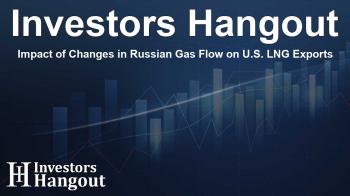Impact of Changes in Russian Gas Flow on U.S. LNG Exports

Inevitability of Changes in Russian Gas Flow
Recent analyses have shown that any alterations in restrictions regarding Russian gas supply to Europe may hold significant implications for U.S. liquefied natural gas (LNG) exports. With the United States currently a major player in Europe’s LNG imports, supplying around 15% of its total gas needs, these changes in gas policy could impact U.S. energy investments and market dynamics.
Effects on U.S. LNG Investment and Projects
A detailed investigation by industry experts suggests potential repercussions amounting to approximately $120 billion in investments across future U.S. LNG projects. As the geopolitical landscape evolves, the demand for U.S. LNG could either surge or decline drastically depending on how things unfold with Russia’s gas availability in Europe.
In an optimistic scenario called "Phasing Down Russian LNG," the U.S. could see an addition of 12 million metric tons per annum (MMtpa) in new LNG projects if Europe opts to significantly reduce its dependency on Russian gas. This move would enhance energy diversity and bring substantial investments nearing $48 billion.
Comparison of Scenarios: What Lies Ahead?
The report outlines various scenarios, contrasting the current trend with more proactive strategies that Europe might adopt regarding Russian energy sources. In a scenario titled "Opening the Taps," the effects are striking; over 17 MMtpa in future U.S. LNG capacity, corresponding to $70 billion, could potentially be curtailed if sanctions on Russian gas are removed, allowing increased competition.
Sanction Impacts on Market Dynamics
Furthermore, industry professional Carlos Pascual emphasized that the unwinding of restrictions could severely undercut U.S. market share. U.S. LNG operators, being highly flexible in contract structures, are often more reactionary to shifts in price signals across global markets. Therefore, a policy shift that favors Russian gas could thrust U.S. exporters into a challenging position.
Investment Insights Through Different Scenarios
Research indicates that the balance of power in the European gas supply market could shift notably, depending on whether Russian gas flows normalize or see further restrictions. A comprehensive understanding of these developments is crucial for stakeholders in the industry, from investors to policymakers.
The Role of Geopolitical Stability
As European supermarkets grapple with their gas supply chains, U.S. LNG's flexibility means it could rapidly adapt to provide solutions. Although potential threats from geopolitical changes loom large, the vast liquidity and contract diversity of U.S. LNG market participants position them uniquely to navigate these turbulent waters effectively.
Studies have indicated that with increasing demands coupled with falling domestic production in Europe, capacity for LNG has become essential in bridging the anticipated gas supply gap. Such a gap, resulting from increasing demand and the phase-out of older contracts, presents a window of opportunity for U.S. exporters if they can seize contracts and invest wisely.
Evaluating Future Scenarios: Potential Outcomes
Based on varied timelines set between 2025 and 2040, the analysis notes specific expected project decisions:
- Current Trend: U.S. LNG projects could see FIDs reaching up to 33.7 MMtpa, bolstering a projected direct expenditure of $138 billion.
- Opening the Taps: This could drastically lower U.S. competitive edge, limiting project FIDs to around 16.5 MMtpa with a reduced expenditure of $67 billion.
- Phasing Down: A complete halt on Russian LNG could escalate U.S. FIDs to approximately 45.5 MMtpa, with expected expenditure soaring to $186 billion.
Ultimately, navigating these waters requires acute awareness and strategic planning. Grounded in sizable investments and adapting policies, U.S. stakeholders stand to gain tremendously from a clear resolution of Europe's energy sourcing strategies.
Frequently Asked Questions
What is the impact of Russian gas flow changes on U.S. LNG?
Changes in Russian gas flow could potentially displace U.S. LNG in the European market, affecting investments and project viability significantly.
What are the scenarios outlined in the study?
The study presents three main scenarios: Current Trend, Opening the Taps, and Phasing Down. Each scenario has differing impacts on U.S. LNG projects and investments.
How much could U.S. LNG investments be affected?
The report suggests that U.S. LNG investments could face impacts close to $120 billion based on the changes in Russian gas policies.
Who conducted the study on U.S. LNG exports?
The analysis was conducted by industry leaders and formed parts of a significant research initiative focusing on global energy dynamics.
What is the outlook for U.S. LNG projects?
Depending on geopolitical circumstances, the outlook remains uncertain, but there are chances of large-scale investments if conditions favor U.S. LNG over Russian gas.
About The Author
Contact Hannah Lewis privately here. Or send an email with ATTN: Hannah Lewis as the subject to contact@investorshangout.com.
About Investors Hangout
Investors Hangout is a leading online stock forum for financial discussion and learning, offering a wide range of free tools and resources. It draws in traders of all levels, who exchange market knowledge, investigate trading tactics, and keep an eye on industry developments in real time. Featuring financial articles, stock message boards, quotes, charts, company profiles, and live news updates. Through cooperative learning and a wealth of informational resources, it helps users from novices creating their first portfolios to experts honing their techniques. Join Investors Hangout today: https://investorshangout.com/
The content of this article is based on factual, publicly available information and does not represent legal, financial, or investment advice. Investors Hangout does not offer financial advice, and the author is not a licensed financial advisor. Consult a qualified advisor before making any financial or investment decisions based on this article. This article should not be considered advice to purchase, sell, or hold any securities or other investments. If any of the material provided here is inaccurate, please contact us for corrections.

